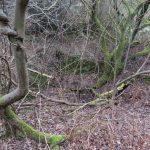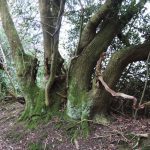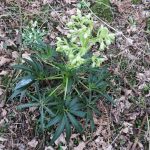Jerry Welsh, ably assisted by Sally Rankin and Alan Parfitt, stepped into the breach at short notice and led a well-attended walk round Nettlebed Common on the morning of Saturday 25 February. Before heading out onto the Common, Jerry showed the group the sole remaining kiln, formerly used for making bricks and tiles. The walk started out along Chapel Lane and onto the Common. In the Clay on the left was a large pond with murky brown water. Jerry explained that rainwater collected in pools like this would have been the sole water supply for the village in bygone times, because Nettlebed is the highest point in the area and there are no springs nearby. According to local legend, the dense clumps of Snowdrops beside the path had originally been planted on the Common by gypsies for picking and selling. A little further on, a deep round pit with no obvious exit ramp was identified as a sink hole. The sink holes form when acidic water from the Clay of the Lambeth beds dissolves the underlying Chalk. Jerry then led the group to one of a series of ponds which have been excavated in a project funded by the Trust for Oxfordshire’s Environment. The ponds are of varying sizes and depths, with some draining into others. Trees have been cleared around the ponds to let in the light. The resulting habitat should be good for amphibians. Around the pond were big clumps of Scaly Male Fern.
Continuing round the Common, the route ran beside boundary banks with big old multi-stemmed trees. Several bright red Scarlet Elf-cup fungi were spotted beside the path. Three male Blackbirds flew past, engaged in a furious dispute and making a great deal of noise. Fresh new Bluebell leaves were showing well beneath the Beech trees. The path continued along the edge of the woods. A group of Red Kites were circling above the adjacent fields and a smaller Sparrowhawk flew above them, with its distinctive flapping and gliding flight. The walk continued up an old sunken trackway and past an enormous old Beech pollard. Back in the village, the path behind the cricket pitch led up to a dry open area on Gravel. Sally explained that when the trees had been cleared and the Bracken litter scraped away, Heather rejuvenated naturally. Priest Hill is a SSSI, designated for its geological importance. A sign described the geology of the area, saying that the Nettlebed gravels were the highest and oldest in the Thames Valley. The gravels consist of rounded flints and small white pebbles of quartz and quartzite. Deposited by a river, they are now 150m above the level of the Thames. Pollen preserved in organic silts and clays comes from one of the earliest inter-glacial periods to be preserved in the Thames catchment. They show the transition from a cool climate with dominant birch to a warmer climate with oak, elm, hornbeam and hazel. The path climbed steeply up to Windmill Hill, then back to the village green, passing a flowering Stinking Hellebore plant on the way.
Pictures by Rob Stallard






